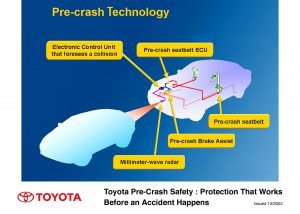Toyota Pre-Crash Safety: Protection That Works Before An Accident Happens
Key points
- Toyota developing Pre-crash Safety, intelligent technology which can predict a crash and launch safety systems ahead of an impact
- Millimetre-wave radar determines unavoidable collisions with other traffic and obstacles
- Triggering of seatbelt retractors and brake assist before an impact increases passenger protection and potentially reduces accident injuries and fatalities
- Pre-crash Safety part of Toyota’s wider programme of Intelligent Transport Systems research and development
- Potential application of new technology in production models during 2003
Today’s cars are equipped with increasingly sophisticated equipment to help you avoid an accident, but there are still times when a collision becomes inevitable. Airbag deployment, pre-tensioning of seatbelts, decoupling of pedals and the absorption of impact forces in defined crumple zones all help protect the driver and passengers, but lives could be saved and injuries could be lessened if certain safety systems were activated immediately before an impact, rather than after it.
Toyota is making a major advance in driver and passenger protection with the development of Pre-crash Safety, a system that recognises when a collision is going to happen. The timing involves just fractions of seconds, but that can be enough to prevent serious injury or even death.
The Toyota Pre-crash System comprises three core elements:
- The Pre-crash sensor, a millimetre-wave radar that detects vehicles and obstacles ahead
- Pre-crash driver and front passenger seatbelts that retract as soon as a collision is identified
- Pre-crash brake assist which increases braking pressure as soon as the driver begins to depress the brake pedal
The radar provides excellent object recognition, even in bad weather and darkness. It feeds information to a control unit equipped with software which determines whether a collision is going to take place on the basis of the course and speed of the vehicle, driver input in steering, throttle and braking, and the position, speed and course of any vehicles or obstacles ahead.
If an impact is judged to be inevitable, the Pre-crash seatbelt retracts to provide the best possible restraint of the driver or passenger. As soon as the driver begins to apply the brakes, the Pre-crash Brake Assist is activated, increasing brake pressure in line with the degree of pressure being exerted on the pedal.
Analysis of around 9,000 annual traffic-related fatalities in Japan revealed that, if Pre-crash Safety had been fitted to all vehicles, one per cent of victims might have survived.
Pre-crash Safety has been under development for 10 years as part of Toyota’s wider Intelligent Transport Systems (ITS) research. Elements of this which have already gone into service include a radar-based cruise control and blind corner monitoring, which gives the driver improved vision at junctions by relaying images from cameras mounted on the front bumper to a dashboard screen.
Toyota’s ITS programme also embraces advanced navigation and public transport systems. Moves are also being made towards fully automatic driving with research into technology which automatically controls vehicle speed, direction and position in relation to other road users.
Pre-crash Safety could find its way into a production vehicle before the end of 2003 but no timetable has been set for its introduction in models for the UKmarket.
ENDS


